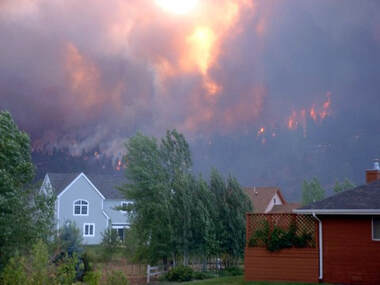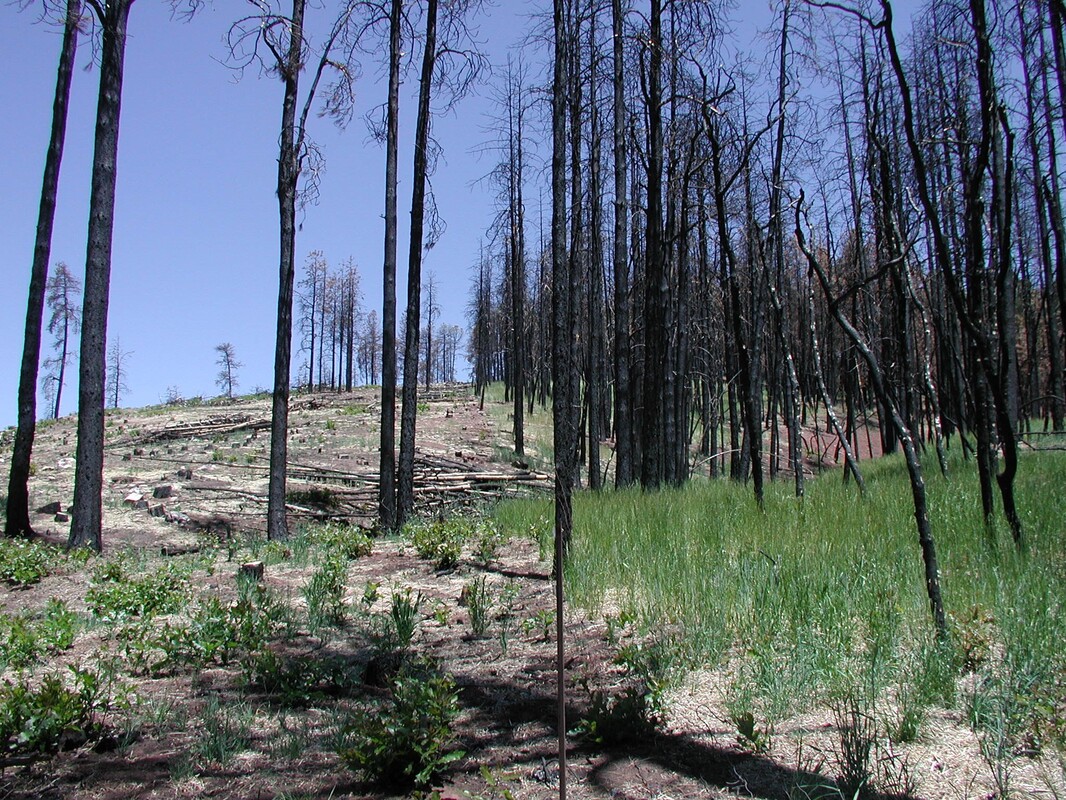Draft for SJNF: Password protected webpage.
Caring for our water.
Our waters... like all gifts that we inherit, they are easy to take for granted. Sustain the gifts that come to us naturally. Your Best Waters, US Forest Service video
Our many water uses, coupled with increasing environmental changes, are causing threats to our precious water cycle. The San Juan National Forest works with a wide variety of community partners to prevent, mitigate and repair impacts from these threats. Here are some of our stories.
Changes in the environment affect our water.
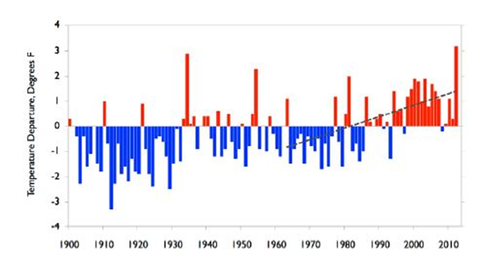
The climate experienced in southwest Colorado over the past 15 years has certainly affected our water. This graph shows average annual temperature in Colorado, and the dashed line shows the current trend of steadily increasing temperature. Warmer temperatures melt our precious reservoir of snowpack water more quickly in the spring and summer and cause winter precipitation to fall as rain so it doesn’t get stored as snowpack at all. Warmer temperatures also heat up mountain stream water, creating conditions that favor non-native fish and increase trout vulnerability to disease. Colorado’s native trout are becoming confined to only the cleanest and coldest streams, now found mostly at higher elevations.
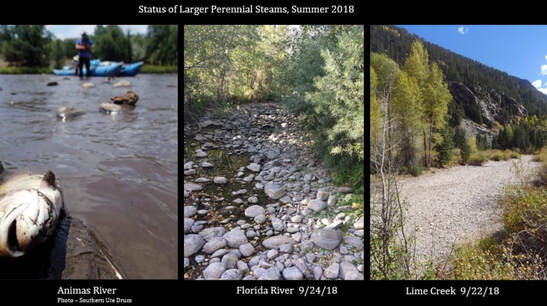
Locally, the past 15 years have been dominated by drought with just a few wet years mixed in. 2017/2018 was an exceptionally dry period and our watersheds suffered accordingly. Rivers flowed at record low levels and many fish-bearing rivers dried up completely. In 2017/2018, the drought was a major factor in the size and severity of several local fires that burned watersheds and polluted our drinking water supplies.
The San Juan National Forest works with Forest Service researchers and with partners, such as Trout Unlimited and Mountain Studies Institute, to measure stream temperatures in many headwater streams of the Dolores and Hermosa Creek watersheds.
The San Juan National Forest works with Forest Service researchers and with partners, such as Trout Unlimited and Mountain Studies Institute, to measure stream temperatures in many headwater streams of the Dolores and Hermosa Creek watersheds.
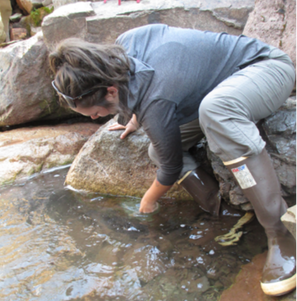 Intern affixes underwater temperature monitor in Hermosa Creek to better understand how this fish-bearing stream is warming over time.
Intern affixes underwater temperature monitor in Hermosa Creek to better understand how this fish-bearing stream is warming over time.
With this information we hope to find the places with the coldest, clean waters that offer the best chance for long-term survival for native trout in the face of changing climate. If we know where these streams are, we can focus restoration and protection measures in the areas that have the best chance of helping cold water fish species in the long-term. To learn more about the Forest Service research in this area, click here.
Warming temperatures coupled with recurring drought can bring increased wildfires. The San Juan National Forest has seen a trend of progressively larger wildfires, more extreme fire behavior, and an ever-increasing length of our fire season. Unusually severe wildfires are becoming one of the greatest risks to clean water supplies in the west.
Water problems often follow severe wildfire because ash and sediment-laden runoff pollute our water. Post-fire runoff can create large floods and landslides that carry away productive topsoil, further diminishing watershed health and slowing recovery.
Warming temperatures coupled with recurring drought can bring increased wildfires. The San Juan National Forest has seen a trend of progressively larger wildfires, more extreme fire behavior, and an ever-increasing length of our fire season. Unusually severe wildfires are becoming one of the greatest risks to clean water supplies in the west.
Water problems often follow severe wildfire because ash and sediment-laden runoff pollute our water. Post-fire runoff can create large floods and landslides that carry away productive topsoil, further diminishing watershed health and slowing recovery.
Colorado's beauty brings more people using water.
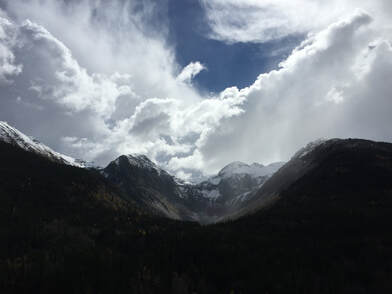
The population of the State of Colorado has grown rapidly over the past few decades. Colorado’s demographers estimate that our population will keep increasing from more than five million today, to almost double that number in just 30 years. This growth will require even more water. Some of the fastest growing places include counties in southwest Colorado. It will be a huge challenge to sustain growth and still preserve the amazing things that we love and that also draw people to our area. Things like the snow-covered Rocky Mountains, diverse wildlife, our precious rivers and lakes, gorgeous scenery, and abundant opportunities to be outside in nature.
Our water supply is finite and we already suffer from shortages for irrigation, municipal, industrial, and recreation needs. Colorado has a Water Plan that recognizes there are gaps between the water available now and Colorado’s future growth needs. Colorado’s Water Plan contains a host of ideas to close the gap in water shortage, including more storage and more conservation.
The Water Plan for southwest Colorado, called the Southwest Basin Implementation Plan, was developed largely by local participants and members of the Southwest Basin Roundtable. You can attend their meetings and contribute your thoughts to solving difficult local water issues. Our local Basin Implementation Plan shows that our biggest future water shortages will be for irrigated agriculture, as well as water to meet increased municipal demand due to rapid population growth. This water plan highlights how challenging it will be to find ways to provide water for a changing future while still protecting the environmental and recreational uses of the rivers we love and depend upon for so many things.
Our water supply is finite and we already suffer from shortages for irrigation, municipal, industrial, and recreation needs. Colorado has a Water Plan that recognizes there are gaps between the water available now and Colorado’s future growth needs. Colorado’s Water Plan contains a host of ideas to close the gap in water shortage, including more storage and more conservation.
The Water Plan for southwest Colorado, called the Southwest Basin Implementation Plan, was developed largely by local participants and members of the Southwest Basin Roundtable. You can attend their meetings and contribute your thoughts to solving difficult local water issues. Our local Basin Implementation Plan shows that our biggest future water shortages will be for irrigated agriculture, as well as water to meet increased municipal demand due to rapid population growth. This water plan highlights how challenging it will be to find ways to provide water for a changing future while still protecting the environmental and recreational uses of the rivers we love and depend upon for so many things.
Our water uses can have lasting consequences.
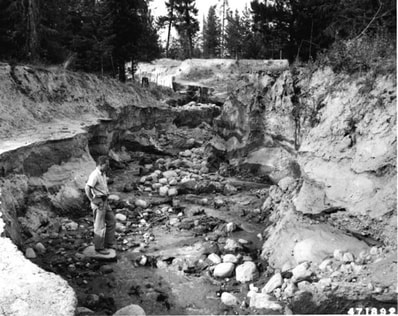 Poor forest and rangeland health often made floods more destructive, damaging streams. Early restoration efforts were undertaken by the Civilian Conservation Corps (CCC).
Poor forest and rangeland health often made floods more destructive, damaging streams. Early restoration efforts were undertaken by the Civilian Conservation Corps (CCC).
More than half of the water used by cities, agriculture, and rural communities in the American west comes from rivers originating on National Forests. All of the watersheds on the San Juan National Forest supply drinking water to downstream communities. Most streams have excellent water quality. However, our traditional practices in mining, grazing, road building, trail use, timber harvest, and water diversions have had negative impacts in some watersheds. And coupled with environmental changes and increased populations, these activities can become even more threatening to our waters.
For example, mining is an important part of Colorado’s colorful history and was the reason many towns such as Silverton, Telluride, and Rico were first established. In the 1800s, silver extraction used primitive technologies that worked for their times but created lasting environmental problems. In the headwaters of the Animas watershed, decades of historic gold and silver mining have resulted in some streams being unusable for drinking and impossible for fish and aquatic creatures to live in.
For example, mining is an important part of Colorado’s colorful history and was the reason many towns such as Silverton, Telluride, and Rico were first established. In the 1800s, silver extraction used primitive technologies that worked for their times but created lasting environmental problems. In the headwaters of the Animas watershed, decades of historic gold and silver mining have resulted in some streams being unusable for drinking and impossible for fish and aquatic creatures to live in.
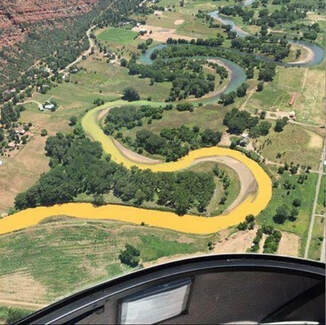 Upper Animas River, summer 2015.
Upper Animas River, summer 2015.
Catastrophic events, such as the Gold King Mine spill of 2015, remind us that it could take generations to fix the damaging legacy of our mining history, while serving as a cautionary tale for careful consideration of the range of future development activities. Pictured is the toxic yellow-colored water of the upper Animas River that resulted from the Gold King Mine spill of three million gallons of metal-laden pollution. This image was carried by many news outlets across the country at the time.
Addressing such complex issues is often best done by a diverse group, and the Animas River Stakeholder Group is a good example. Created in 1994 with the primary mission of improving water quality degraded from mine pollution, the group's members include community and non-profit groups, industry, and governmental agencies, all working together to find ways to reduce mine pollution. Read more about the stakeholder group and how you can participate here.
Addressing such complex issues is often best done by a diverse group, and the Animas River Stakeholder Group is a good example. Created in 1994 with the primary mission of improving water quality degraded from mine pollution, the group's members include community and non-profit groups, industry, and governmental agencies, all working together to find ways to reduce mine pollution. Read more about the stakeholder group and how you can participate here.

